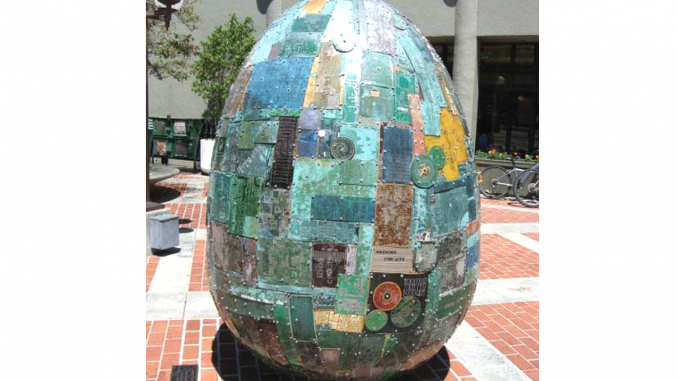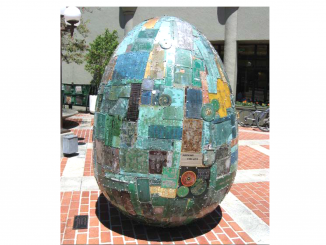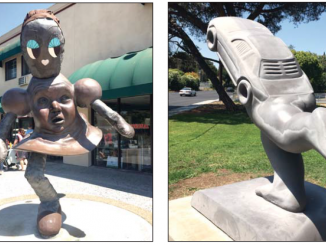
BY ALLISON LEVITSKY
Daily Post Staff Writer
The New York City artist behind “Digital DNA,” the 7-foot-tall, egg-shaped circuit board sculpture at Lytton Plaza, has threatened to sue the city of Palo Alto over its plan to remove her statue later this month.
Adriana Varella has hired Nicholas O’Donnell, a lawyer with the New York firm Sullivan and Worcester, to represent her.
In a letter to Councilman Greg Scharff on Wednesday, O’Donnell claims that the city is violating the federal Visual Artists Rights Act of 1990, which protects artists from having their work modified in a way that harms the artist’s reputation.
It also prevents the destruction of artwork of recognized stature. Varella was in talks with Menlo College in November to possibly move “Digital DNA” to its Atherton campus. But Varella is no longer considering that option and says that the egg is “site-specific” to downtown Palo Alto because of the city’s role as the birthplace of Silicon Valley.
The city’s Public Art Commission voted on Nov. 16 to remove the 13-year-old sculpture because of the amount of maintenance it requires, including clear coatings of the circuit boards, replacements of broken boards and regular filling and replacement of screws that have popped out of the fiberglass shell. The city gave her until Feb. 23 to remove the sculpture.
Repairs
Since 2005, the city has spent $16,294 on repairs for the egg, including removal and reinstallation for the purpose of repair. Varella was not told that her sculpture could be removed when she agreed to build it for $9,950 in 2000.
O’Donnell argues that maintaining the work by reapplying a protective coating every four or five months is “neither overly burdensome nor expensive,” and that the cost of maintaining the sculpture of “a little over $1,000 per year” doesn’t constitute excessive maintenance expense.
The egg’s circuit boards feature phrases about technology etched in different languages. A 2005 press release said that it offered “a momentary reflection about what we have been building, researching and planning for our software and hardware thinkers.”
The commission is also planning to remove “Go Mama,” the 6-foot-tall bronze doll with a face on its belly on California Avenue at Ash Street. Both decisions were made in accordance with the city’s Deaccession of Artwork Policy, which was approved in February 2017.
The deaccession policy allows for the removal of city-owned art if it meets one or more of 13 criteria, including if the piece’s condition or security can’t be guaranteed, if it requires excessive maintenance or if the work has been damaged or has deteriorated and repair is impractical.
Online petition
Varella has also created an online petition to rally support for keeping the sculpture at Lytton Plaza. The petition, which can be found at https://diy.rootsaction.org/petitions/friends-of-digital-dna, had collected 158 signatures yesterday.



